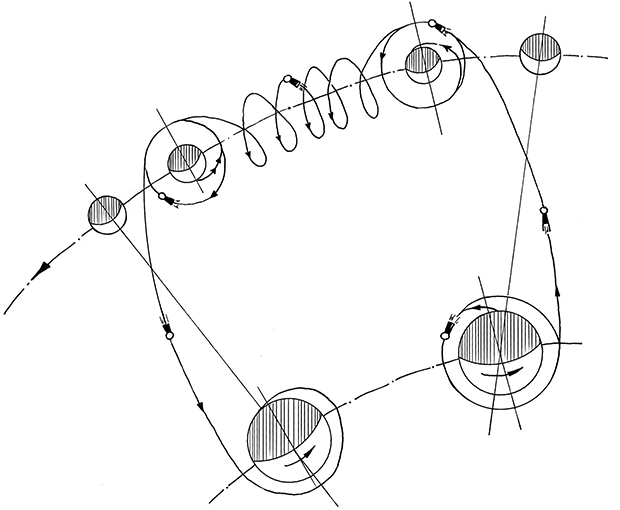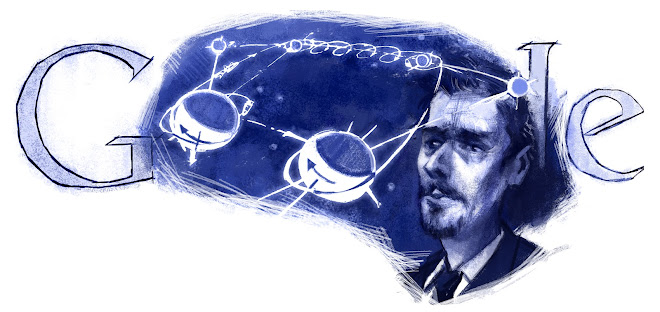KondratyukYuriy
ShargeyOleksandr
June 21, 1897, Poltava, Russian Empire (now Ukraine) —
probably February 23, 1942, Oryol region, USSR (now Russia)
The track of Kondratyuk
After Yuri Gagarin went into space in 1961, the future that was previously described in books: the base on the moon, the colonization of the planets of the solar system, the elevator into space, a trip to Alpha Centauri and more, began to seem less fantastic. The largest countries were trying to bring such a future closer, and the NASA team was given the task of landing a man on the moon by the end of the 1960s.

When the engineers began to develop a flight program, it became clear — it will be really difficult not to forward a person to the Moon, but also to return him or her from there to Earth. Some scientists have proposed to launch a super-powerful rocket with enough fuel to cover the earth’s and lunar gravity during launch from both surfaces, and on the way back and forth. Others wanted to launch two rockets into Earth orbit: one with additional fuel and the other with a spaceship. After refueling in orbit, the astronauts had to move to the Moon and then launch from the surface of the satellite, having a sufficient supply of fuel. John Gubolt proposed a completely different plan. At first it was not taken seriously, but finally it was used.
On July 16, 1969, the Saturn V launch vehicle launched the Apollo 11 spacecraft into the lunar trajectory, carrying Neil Armstrong, Michael Collins and Buzz Aldrin. When the ship reached the orbit of the satellite 76 hours after launch, Armstrong and Aldrin moved to the landing module and began to prepare for docking. They were to land on the moon in this module, and Collins was to remain in orbit and wait for them to return. On July 20, at 8:17 pm GMT, the module made a successful landing. Although the module lasted a total of almost 22 hours on the Moon, the astronauts spent only two and a half hours outside it. When the astronauts did everything planned on the Moon and returned to the module, his takeoff foot took off from the surface of the satellite and 3 hours and 41 minutes later docked with the spacecraft. Armstrong and Aldrin joined Collins, discarded the unnecessary module, and headed home.
If the way astronauts first reached the Moon and returned was suggested by Gubolt, then why is it called the track of Kondratyuk?
In March 1969, after Apollo 9 took on a test flight, Gubol gave an interview to Life magazine in which he said that when he looked at the launch of Apollo 9, he was thinking of another engineer whose ideas were once taken skeptical. Shortly before that, he learned about Yuriy Kondratyuk, a self-taught engineer who 50 years ago calculated the same trajectory that was best for landing on the Moon. “My God, he went through the same thing I did”, — Gubolt said.

The track of Kondratyuk
The one known to the world as Yuriy Kondratyuk was actually Oleksandr Shargey, but he had to change his name to survive the difficult 1900s. He really was a self-taught graduate of high school, and studied at the Polytechnic Institute for only a couple of months — there was an insurrection, and then everything went awry. The books and articles he managed to obtain were the only source of knowledge. At the age of 17, Shargey began filling his school notebook with dreams of space flight, and in a few years it was filled with mathematical calculations and turned into real scientific work. Use of locks and spacesuits to go into outer space, solar energy to heat the ship, gravity of celestial bodies to correct the flight, landing modules to stop on celestial bodies, extraterrestrial intermediate bases, stabilization and flight control. He first described the way Americans then got to the moon in this scientific paper. In 1929, several more supplemented and expanded the work entitled “The Conquest of Interplanetary Space” (this happened under the name of Yuriy Kondratyuk) managed to publish a circulation of 2000 copies. He presented one of the copies to the legendary Tsiolkovsky, with whom he corresponded a lot after that. Another copy fell into the hands of Sergei Korolyov, who invited Kondratyuk to join his team to work on rocket engines, but either for fear that the inspections would reveal his real name and origin, or for other reasons Kondratyuk refused. He was at work upon new ideas and their justification, as well as writing everything on the pages of ordinary school notebooks. In 1942, during World War II, Kondratyuk disappeared without a trace, but his notebooks have survived.
In 1964, the USSR published the book “Pioneers of Missile Technology”, which collected the stories and works of prominent engineers, including Yuriy Kondratyuk. This book was translated and published in English by NASA. Probably, this book got into the hands of John Gubolt after he “rediscovered” the way to the moon and back.

On June 21, 2012, Google released a doodle in honor of Yuri Kondratyuk’s 115th birthday.
American engineers did not spy on the idea and did not use the calculations of Yuriy Kondratyuk, but in memory of the discoverer of this route named after him, and in 2014 the name of Yuri Kondratyuk was inducted into the International Space Hall of Fame.